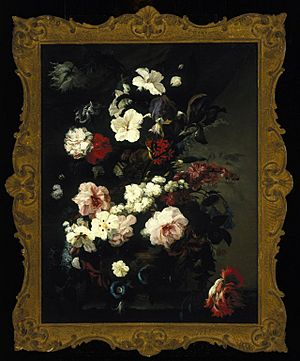Mary Moser facts for kids
Quick facts for kids
Mary Moser
|
|
|---|---|

A portrait of Mary Moser by George Romney
|
|
| Born | 27 October 1744 London
|
| Died | 2 May 1819 (aged 74) |
| Nationality | British |
| Spouse(s) | Hugh Lloyd |
| Patron(s) | Queen Charlotte |
Mary Moser RA (born October 27, 1744 – died May 2, 1819) was a famous English painter. She was one of the most well-known female artists in Britain during the 1700s. Mary Moser was one of only two women who helped start the Royal Academy in 1768. The other was Angelica Kauffman. Moser painted many portraits, but she was especially famous for her beautiful flower paintings.
Contents
Mary Moser's Early Life and Art Career
Mary Moser was born in London. Her father, George Michael Moser, was an artist from Switzerland who worked with enamel. He was also the drawing teacher for King George III. Mary learned to paint from her father.
She showed her artistic talent from a young age. When she was just 14, she won her first medal from the Society of Arts. She often showed her flower paintings and sometimes history paintings at the Society of Artists of Great Britain.
Ten years later, Mary wanted more recognition for her art. So, she joined 35 other artists, including her father, to create the Royal Academy. She and Angelica Kauffman were the only two women among the founding members. They both played an active role in the Academy's early days.
In a famous painting by Johan Zoffany called The Academicians of the Royal Academy (painted between 1771 and 1772), the artists are shown gathered around a male model. At that time, women were not allowed to attend these classes with male models. To include Mary Moser and Angelica Kauffman, Zoffany painted their portraits hanging on the wall instead.
Around 1770, the artist George Romney painted a portrait of Mary Moser. It shows her working on a still life painting. This portrait is now kept at the National Portrait Gallery in London.
Mary Moser was inspired by older Dutch painters. These artists were known for their bright colors set against dark backgrounds. From the very beginning, Mary's paintings were described as "bold and luxurious."
Important Works and Later Life
In the 1790s, Mary Moser received a very important job from Queen Charlotte. The Queen paid her a lot of money, over £900, to create flower decorations for a room in Frogmore House. Frogmore House is located in Windsor, Berkshire.
This project was one of her last big professional works. When she was 53, Mary married Captain Hugh Lloyd on October 23, 1793. He was a friend's widower. After getting married, she stopped working as a professional artist and began showing her art as a hobby. She continued to exhibit her paintings at the Royal Academy until 1802.
Mary Moser was known as "one of the most celebrated women artists of 18th-century Britain." She passed away in London on May 2, 1819. She was buried next to her husband in Kensington Cemetery.
Mary Moser's artworks in the British Royal Collection show that she was not only "the first important British flower painter, she was also one of the best." Her portrait of the famous British sculptor Joseph Nollekens is displayed at the Yale Center for British Art.
Mary Moser's Legacy
After Mary Moser's death in 1819, no other women were chosen as full members of the Royal Academy for a long time. The next woman to become a full member was Dame Laura Knight in 1936.
See also
 In Spanish: Mary Moser para niños
In Spanish: Mary Moser para niños


